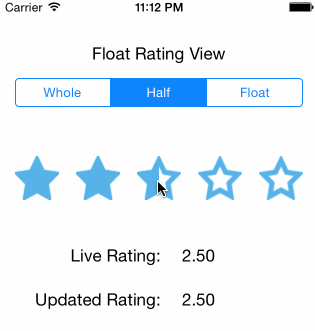FloatRatingView alternatives and similar libraries
Based on the "UI" category.
Alternatively, view FloatRatingView alternatives based on common mentions on social networks and blogs.
-
Animated Tab Bar
:octocat: RAMAnimatedTabBarController is a Swift UI module library for adding animation to iOS tabbar items and icons. iOS library made by @Ramotion -
JTAppleCalendar
The Unofficial Apple iOS Swift Calendar View. Swift calendar Library. iOS calendar Control. 100% Customizable -
FSPagerView
FSPagerView is an elegant Screen Slide Library. It is extremely helpful for making Banner View、Product Show、Welcome/Guide Pages、Screen/ViewController Sliders. -
Pagemenu
A paging menu controller built from other view controllers placed inside a scroll view (like Spotify, Windows Phone, Instagram) -
SwipeCellKit
Swipeable UITableViewCell/UICollectionViewCell based on the stock Mail.app, implemented in Swift. -
SwiftEntryKit
SwiftEntryKit is a presentation library for iOS. It can be used to easily display overlays within your iOS apps. -
Material Components for iOS
[In maintenance mode] Modular and customizable Material Design UI components for iOS -
SideMenu
Simple side/slide menu control for iOS, no code necessary! Lots of customization. Add it to your project in 5 minutes or less. -
Scrollable-GraphView
An adaptive scrollable graph view for iOS to visualise simple discrete datasets. Written in Swift. -
Alerts Pickers
Advanced usage of UIAlertController and pickers based on it: Telegram, Contacts, Location, PhotoLibrary, Country, Phone Code, Currency, Date... -
ESTabBarController
:octocat: ESTabBarController is a Swift model for customize UI, badge and adding animation to tabbar items. Support lottie! -
NotificationBanner
The easiest way to display highly customizable in app notification banners in iOS -
ActiveLabel
UILabel drop-in replacement supporting Hashtags (#), Mentions (@) and URLs (http://) written in Swift -
SlideMenuControllerSwift
iOS Slide Menu View based on Google+, iQON, Feedly, Ameba iOS app. It is written in pure swift. -
PopupDialog
A simple, customizable popup dialog for iOS written in Swift. Replaces UIAlertController alert style. -
TLYShyNavBar
DISCONTINUED. Unlike all those arrogant UINavigationBar, this one is shy and humble! Easily create auto-scrolling navigation bars! -
KMNavigationBarTransition
A drop-in universal library helps you to manage the navigation bar styles and makes transition animations smooth between different navigation bar styles while pushing or popping a view controller for all orientations. And you don't need to write any line of code for it, it all happens automatically. -
Whisper
:mega: Whisper is a component that will make the task of display messages and in-app notifications simple. It has three different views inside -
StarWars.iOS
This component implements transition animation to crumble view-controller into tiny pieces. -
CircleMenu
:octocat: ⭕️ CircleMenu is a simple, elegant UI menu with a circular layout and material design animations. Swift UI library made by @Ramotion -
RazzleDazzle
A simple keyframe-based animation framework for iOS, written in Swift. Perfect for scrolling app intros. -
PaperOnboarding
:octocat: PaperOnboarding is a material design UI slider. Swift UI library by @Ramotion
WorkOS - The modern identity platform for B2B SaaS

* Code Quality Rankings and insights are calculated and provided by Lumnify.
They vary from L1 to L5 with "L5" being the highest.
Do you think we are missing an alternative of FloatRatingView or a related project?
README
FloatRatingView
A simple rating view for iOS written in Swift! Supports whole, half or floating point values. I couldn't find anything that easily set floating point ratings, so I made this control based on a Ray Wenderlich tutorial. Some of the best iOS tutorials that I've come across.
Check out the post on medium for a full write-up. https://medium.com/@glenyi/float-rating-view-in-swift-e740b6b9404d

Usage
Initialize from a nib/xib or programmatically. Set the empty and full image, then you're pretty much good to go! Check out the demo app to see how it can be used.
Release v4.0 is updated for Swift 5.0 while v1.0.3 is on Swift 2.3.
Usage in an Objective-C Project
- Import the Swift File
- Ensure the build settings in your project are set to enable Swift usage (see here and here)
import "YOUR_PROJECT_NAME-Swift.h"in your Objective-C files where you want to useFloatRatingView
Pod Installation
For Swift 2.3 projects just add the following to your podfile:
pod 'FloatRatingView', '~> 1.0.3'
For Swift 5.0 projects:
pod 'FloatRatingView', '~> 4'
How it works
The concept is a little different from the source tutorial. The float rating view lays the full image views on top of the empty image views then sets the CALayer mask property to partially hide full images. The full image view mask frame is calculated whenever needed for half or floating point values.

